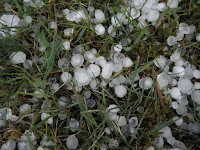The majority of roof leaks are easy repairs once the source of the leak has been determined. Determining the source is the biggest problem. When you have a drip coming from your ceiling, that doesn’t mean that is where the leak is located. Water runs downhill, so the actual leak could be from the other side of the house.
There are several things that can be the cause of a roof leak. For instance, AC and plumbing can cause a misdiagnosed roof leak. And with spring weather in this part of the country, hail damage and wind damage are number one in roof leaks. Some other roof leaks can be:
- Cracked, loose, missing shingles or tiles
- Damaged or deteriorated caulking, flashing, or seals
- Poor attic ventilation
- Poorly installed collars, flashings, shingles, or valleys
- Ice dams
- Pooled or ponding water
- Nail heads exposed
- Skylights
- Debris built up
Many of these things you can stop before they cause roof leaks by doing a monthly check of your roof. If you aren’t able to see the top of your roof from the ground and aren’t comfortable climbing a ladder, give us a call at Dunrite Roofing. After a hail storm in the area, it is wise to have your roof checked before you notice a leak.


